NLTK基础
Python上著名的⾃然语⾔处理库
- ⾃带语料库,词性分类库
- ⾃带分类,分词,等等功能
- 强⼤的社区⽀持
- 还有N多的简单版wrapper
安装语料库
# 方式一
import nltk
nltk.download() showing info https://raw.githubusercontent.com/nltk/nltk_data/gh-pages/index.xml
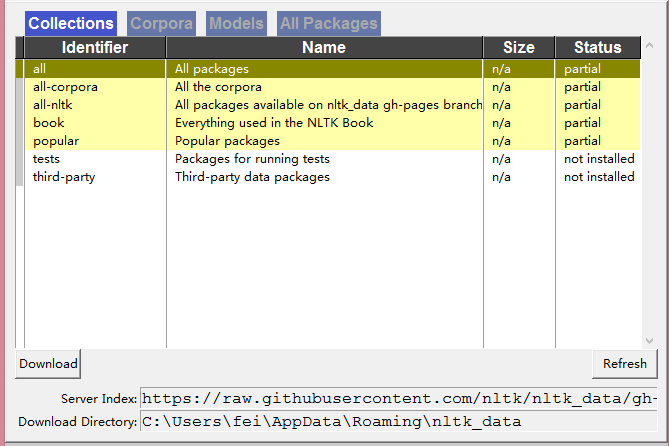
若下载速度慢或因其他原因下载失败
官方下载地址 http://www.nltk.org/nltk_data/¶
githup下载地址 https://github.com/nltk/nltk_data
- 下载packages文件,重命名为nltk_data
from nltk import data
data.path.append('D:/python3.6/nltk_data')
功能一览表
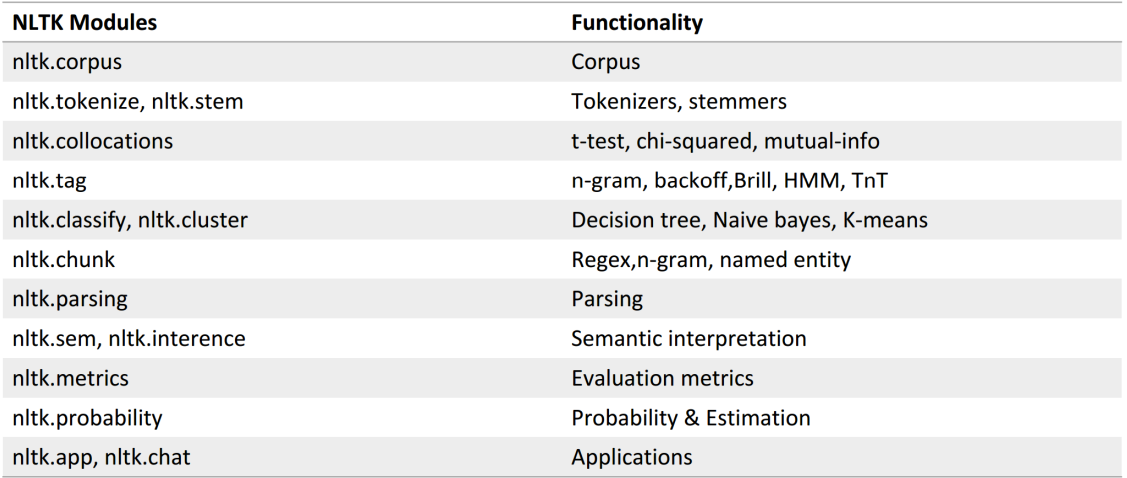
下载语料库
# 请下载
nltk.download('brown') [nltk_data] Downloading package brown to
[nltk_data] C:\Users\fei\AppData\Roaming\nltk_data...
[nltk_data] Unzipping corpora\brown.zip.
nltk自带语料库
# nltk自带语料库
from nltk.corpus import brown
brown.categories()
['adventure',
'belles_lettres',
'editorial',
'fiction',
'government',
'hobbies',
'humor',
'learned',
'lore',
'mystery',
'news',
'religion',
'reviews',
'romance',
'science_fiction']
brown.readme() # 语料信息描述 print(brown.words()[:10]) # 单词
print(len(brown.words())) ['The', 'Fulton', 'County', 'Grand', 'Jury', 'said', 'Friday', 'an', 'investigation', 'of']
1161192 print(brown.sents()[:10]) # 句子
print(brown.sents().__len__())
[['The', 'Fulton', 'County', 'Grand', 'Jury', 'said', 'Friday', 'an', 'investigation', 'of', "Atlanta's", 'recent', 'primary', 'election', 'produced', '``', 'no', 'evidence', "''", 'that', 'any', 'irregularities', 'took', 'place', '.'], ['The', 'jury', 'further', 'said', 'in', 'term-end', 'presentments', 'that', 'the', 'City', 'Executive', 'Committee', ',', 'which', 'had', 'over-all', 'charge', 'of', 'the', 'election', ',', '``', 'deserves', 'the', 'praise', 'and', 'thanks', 'of', 'the', 'City', 'of', 'Atlanta', "''", 'for', 'the', 'manner', 'in', 'which', 'the', 'election', 'was', 'conducted', '.'], ['The', 'September-October', 'term', 'jury', 'had', 'been', 'charged', 'by', 'Fulton', 'Superior', 'Court', 'Judge', 'Durwood', 'Pye', 'to', 'investigate', 'reports', 'of', 'possible', '``', 'irregularities', "''", 'in', 'the', 'hard-fought', 'primary', 'which', 'was', 'won', 'by', 'Mayor-nominate', 'Ivan', 'Allen', 'Jr.', '.'], ['``', 'Only', 'a', 'relative', 'handful', 'of', 'such', 'reports', 'was', 'received', "''", ',', 'the', 'jury', 'said', ',', '``', 'considering', 'the', 'widespread', 'interest', 'in', 'the', 'election', ',', 'the', 'number', 'of', 'voters', 'and', 'the', 'size', 'of', 'this', 'city', "''", '.'], ['The', 'jury', 'said', 'it', 'did', 'find', 'that', 'many', 'of', "Georgia's", 'registration', 'and', 'election', 'laws', '``', 'are', 'outmoded', 'or', 'inadequate', 'and', 'often', 'ambiguous', "''", '.'], ['It', 'recommended', 'that', 'Fulton', 'legislators', 'act', '``', 'to', 'have', 'these', 'laws', 'studied', 'and', 'revised', 'to', 'the', 'end', 'of', 'modernizing', 'and', 'improving', 'them', "''", '.'], ['The', 'grand', 'jury', 'commented', 'on', 'a', 'number', 'of', 'other', 'topics', ',', 'among', 'them', 'the', 'Atlanta', 'and', 'Fulton', 'County', 'purchasing', 'departments', 'which', 'it', 'said', '``', 'are', 'well', 'operated', 'and', 'follow', 'generally', 'accepted', 'practices', 'which', 'inure', 'to', 'the', 'best', 'interest', 'of', 'both', 'governments', "''", '.'], ['Merger', 'proposed'], ['However', ',', 'the', 'jury', 'said', 'it', 'believes', '``', 'these', 'two', 'offices', 'should', 'be', 'combined', 'to', 'achieve', 'greater', 'efficiency', 'and', 'reduce', 'the', 'cost', 'of', 'administration', "''", '.'], ['The', 'City', 'Purchasing', 'Department', ',', 'the', 'jury', 'said', ',', '``', 'is', 'lacking', 'in', 'experienced', 'clerical', 'personnel', 'as', 'a', 'result', 'of', 'city', 'personnel', 'policies', "''", '.']]
57340 print(brown.tagged_words()[:10]) # 词性标注
print(brown.tagged_words().__len__())
[('The', 'AT'), ('Fulton', 'NP-TL'), ('County', 'NN-TL'), ('Grand', 'JJ-TL'), ('Jury', 'NN-TL'), ('said', 'VBD'), ('Friday', 'NR'), ('an', 'AT'), ('investigation', 'NN'), ('of', 'IN')]
1161192
二、文本处理流程
1.preprocess
2.tokenize
3.stopwords
4....
5.make features
6.machine learning
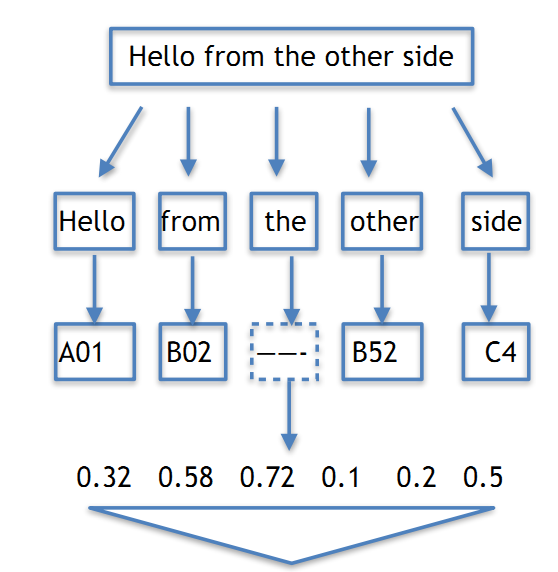
一、Tokenize
把句子拆成有意义的小部件
import nltk
sentence = 'Never underestimate the heart of a champion '
tokens = nltk.word_tokenize(sentence)
tokens
['Never', 'underestimate', 'the', 'heart', 'of', 'a', 'champion']
中文分词
import jieba
seg_list = jieba.cut("我来到北京清华⼤学", cut_all=True)
print("全模式:", "/ ".join(seg_list)) # 全模式
seg_list = jieba.cut("我来到北京清华⼤学", cut_all=False)
print("精确模式:", "/ ".join(seg_list)) # 精确模式
seg_list = jieba.cut("他来到了⽹易杭研⼤厦") # 默认是精确模式
print('新词识别:',", ".join(seg_list))
seg_list = jieba.cut_for_search("⼩明硕⼠毕业于中国科学院计算所,后在⽇本京都⼤学深造")
print('搜索引擎模式:',','.join(seg_list)) 全模式: 我/ 来到/ 北京/ 清华/ / / 学
精确模式: 我/ 来到/ 北京/ 清华/ ⼤/ 学
新词识别: 他, 来到, 了, ⽹, 易, 杭研, ⼤, 厦
搜索引擎模式: ⼩,明硕,⼠,毕业,于,中国,科学,学院,科学院,中国科学院,计算,计算所,,,后,在,⽇,本,京都,⼤,学,深造
社交网络语言的分词
例子
# 社交网络语言的tokenize
from nltk.tokenize import word_tokenize tweet = 'RT @angelababy: love you baby! :D http://ah.love #168cm'
print(word_tokenize(tweet))
['RT', '@', 'angelababy', ':', 'love', 'you', 'baby', '!', ':', 'D', 'http', ':', '//ah.love', '#', '168cm']
解决方法:正则表达式过滤
import re
emoticons_str = r"""
(?:
[:=;] # 眼睛
[oO\-]? # ⿐⼦
[D\)\]\(\]/\\OpP] # 嘴
)"""
regex_str = [
emoticons_str,
r'<[^>]+>', # HTML tags
r'(?:@[\w_]+)', # @某⼈
r"(?:\#+[\w_]+[\w\'_\-]*[\w_]+)", # 话题标签
r'http[s]?://(?:[a-z]|[0-9]|[$-_@.&+]|[!*\(\),]|(?:%[0-9a-f][0-9a-f]))+',
# URLs
r'(?:(?:\d+,?)+(?:\.?\d+)?)', # 数字
r"(?:[a-z][a-z'\-_]+[a-z])", # 含有 - 和 ‘ 的单词
r'(?:[\w_]+)', # 其他
r'(?:\S)' # 其他
]
正则表达式对照表
http://www.regexlab.com/zh/regref.htm¶
tokens_re = re.compile(r'('+'|'.join(regex_str)+')', re.VERBOSE | re.IGNORECASE)
emoticon_re = re.compile(r'^'+emoticons_str+'$', re.VERBOSE | re.IGNORECASE)
def tokenize(s):
return tokens_re.findall(s)
def preprocess(s, lowercase=False):
tokens = tokenize(s)
if lowercase:
tokens = [token if emoticon_re.search(token) else token.lower() for token in
tokens]
return tokens
tweet = 'RT @angelababy: love you baby! :D http://ah.love #168cm'
print(preprocess(tweet))
['RT', '@angelababy', ':', 'love', 'you', 'baby', '!', ':D', 'http://ah.love', '#168cm']
二、词型归一化
纷繁复杂的词形
- Inflection变化: walk => walking => walked
- 影响词性
- derivation 引申: nation (noun) => national (adjective) => nationalize (verb)
- 不影响词性
Stemming 词⼲提取:⼀般来说,就是把不影响词性的inflection的⼩尾巴砍掉
- walking 砍ing = walk
- walked 砍ed = walk
- Lemmatization 词形归⼀:把各种类型的词的变形,都归为⼀个形式
- went 归⼀ = go
- are 归⼀ = be
1. 词干提取
from nltk.stem.porter import PorterStemmer
porter_stemmer = PorterStemmer()
print(porter_stemmer.stem('maximum'))
print(porter_stemmer.stem('presumably'))
print(porter_stemmer.stem('multiply'))
print(porter_stemmer.stem('provision')) maximum
presum
multipli
provis
2. 词型归一
from nltk.stem import WordNetLemmatizer
wordnet_lemmatizer = WordNetLemmatizer()
print(wordnet_lemmatizer.lemmatize('dogs'))
print(wordnet_lemmatizer.lemmatize('churches'))
print(wordnet_lemmatizer.lemmatize('aardwolves'))
print(wordnet_lemmatizer.lemmatize('abaci'))
print(wordnet_lemmatizer.lemmatize('hardrock')) dog
church
aardwolf
abacus
hardrock
没有pos tag,,默认是nn
# ⽊有POS Tag,默认是NN 名词
wordnet_lemmatizer.lemmatize('are')
'are'
wordnet_lemmatizer.lemmatize('is')
'is'
词性标注
方式一:手动标注
# 加上POS Tag
print(wordnet_lemmatizer.lemmatize('is', pos='v'))
print(wordnet_lemmatizer.lemmatize('are', pos='v'))
'be'
'be'
方式二:
import nltk
text = nltk.word_tokenize('what does the fox say')
print(text)
print(nltk.pos_tag(text))
['what', 'does', 'the', 'fox', 'say']
[('what', 'WDT'), ('does', 'VBZ'), ('the', 'DT'), ('fox', 'NNS'), ('say', 'VBP')]
词性关系表
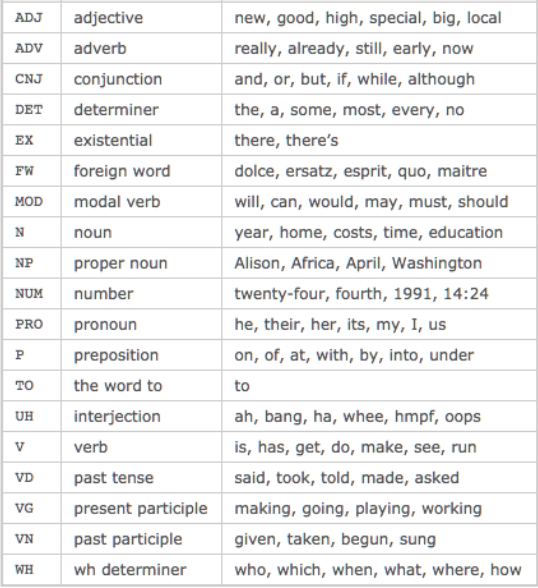
三、Stopwords
⼀千个HE有⼀千种指代
⼀千个THE有⼀千种指事
对于注重理解⽂本『意思』的应⽤场景来说
歧义太多
全体stopwords列表 http://www.ranks.nl/stopwords
nltk去除stopwords
⾸先记得在console⾥⾯下载⼀下词库
或者nltk.download(‘stopwords’)
from nltk.corpusimportstopwords
#先token⼀把,得到⼀个word_list
# ...
#然后filter⼀把
filtered_words =
[wordforwordinword_listifwordnot instopwords.words('english')]
四、nltk频率统计
import nltk
from nltk import FreqDist
# 做个词库先
corpus = 'this is my sentence ' \
'this is my life ' \
'this is the day'
# 随便tokenize⼀下
# 显然, 正如上⽂提到,
# 这⾥可以根据需要做任何的preprocessing:
# stopwords, lemma, stemming, etc.
tokens = nltk.word_tokenize(corpus)
print(tokens)
['this', 'is', 'my', 'sentence', 'this', 'is', 'my', 'life', 'this', 'is', 'the', 'day']
# 借⽤NLTK的FreqDist统计⼀下⽂字出现的频率
fdist = FreqDist(tokens)
# 它就类似于⼀个Dict
# 带上某个单词, 可以看到它在整个⽂章中出现的次数
print(fdist.most_common(50))
for k,v in fdist.items():
print(k,v) [('this', 3), ('is', 3), ('my', 2), ('sentence', 1), ('life', 1), ('the', 1), ('day', 1)]
this 3
is 3
my 2
sentence 1
life 1
the 1
day 1 # 好, 此刻, 我们可以把最常⽤的50个单词拿出来
standard_freq_vector = fdist.most_common(50)
size = len(standard_freq_vector)
print(standard_freq_vector) [('this', 3), ('is', 3), ('my', 2), ('sentence', 1), ('life', 1), ('the', 1), ('day', 1)]
Func: 按照出现频率⼤⼩, 记录下每⼀个单词的位置
def position_lookup(v):
res = {}
counter = 0
for word in v:
res[word[0]] = counter
counter += 1
return res
# 把标准的单词位置记录下来
standard_position_dict = position_lookup(standard_freq_vector)
print(standard_position_dict)
# 得到⼀个位置对照表
{'this': 0, 'is': 1, 'my': 2, 'sentence': 3, 'life': 4, 'the': 5, 'day': 6}
这时,我们有个新句子
[1, 1, 0, 0, 0, 0, 0]sentence = 'this is cool'
# 先新建⼀个跟我们的标准vector同样⼤⼩的向量
freq_vector = [0] * size
# 简单的Preprocessing
tokens = nltk.word_tokenize(sentence)
# 对于这个新句⼦⾥的每⼀个单词
for word in tokens:
try:
# 如果在我们的词库⾥出现过
# 那么就在"标准位置"上+1
freq_vector[standard_position_dict[word]] += 1
except KeyError:
# 如果是个新词
# 就pass掉
continue
print(freq_vector)
# 第⼀个位置代表 is, 出现了⼀次
# 第⼆个位置代表 this, 出现了⼀次
# 后⾯都⽊有
[1, 1, 0, 0, 0, 0, 0]
五、nltk实现tf-idf
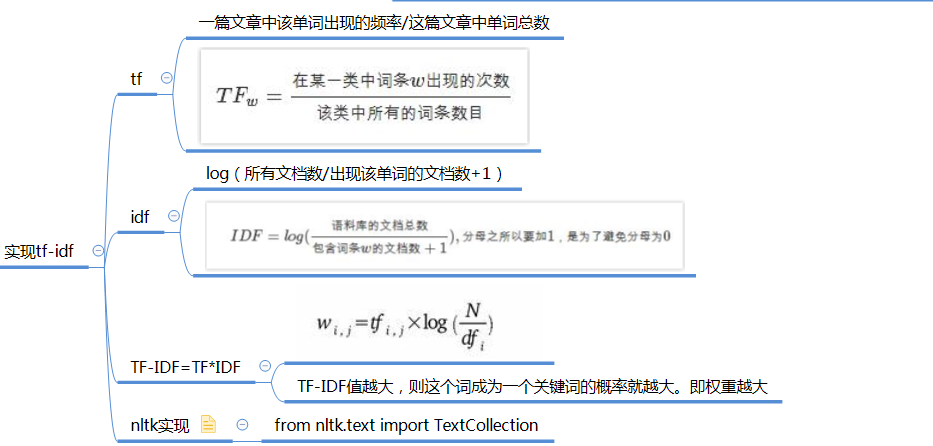
import nltk
from nltk.text import TextCollection
sents = ['this is sentence one', 'this is sentence two', 'this is sentence three']
sents = [nltk.word_tokenize(sent) for sent in sents]
corpus = TextCollection(sents) # 直接就能算出tfidf
# (term: ⼀句话中的某个term, text: 这句话)
print(corpus.idf('three'))
print(corpus.tf('four',nltk.word_tokenize('this is a sentence four')))
print(corpus.tf_idf('four',nltk.word_tokenize('this is a sentence four'))) 1.0986122886681098
0.2
0.0
六、svd降维
%matplotlib inline
import numpy as np
import matplotlib.pyplot as plt
la = np.linalg
words = ['I','like','enjoy','deep','learning','NLP','flying']
X = np.array([[0,2,1,0,0,0,0,0],
[2,0,0,1,0,1,0,0],
[1,0,0,0,0,0,1,0],
[0,1,0,0,1,0,0,0],
[0,0,0,1,0,0,0,1],
[0,1,0,0,0,0,0,1],
[0,0,1,0,0,0,0,1],
[0,0,0,0,1,1,1,0],
])
U,s,Vh = la.svd(X,full_matrices=False)
# print(U,s,Vh)
for i in range(len(words)):
plt.text(U[i,0],U[i,1],words[i]) plt.xlim(-1,1)
plt.ylim(-1,1)
plt.show()
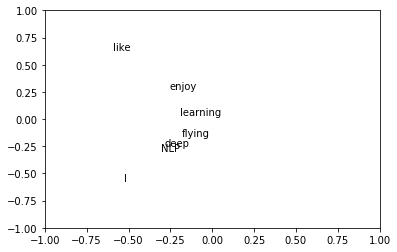
七、nltk经典应用-情感分析
简单的情感分析
import nltk
words = nltk.word_tokenize('I am very happy,i love you')
sentiment_dictionary = {}
for line in open('data/AFINN/AFINN-111.txt'):
word, score = line.split('\t')
sentiment_dictionary[word] = int(score)
# 把这个打分表记录在⼀个Dict上以后
# 跑⼀遍整个句⼦,把对应的值相加
total_score = sum(sentiment_dictionary.get(word, 0) for word in words)
# 有值就是Dict中的值,没有就是0
# 于是你就得到了⼀个 sentiment score
print(total_score)
6
配上ML的情感分析
from nltk.classify import NaiveBayesClassifier
# 随⼿造点训练集
s1 = 'this is a good book'
s2 = 'this is a awesome book'
s3 = 'this is a bad book'
s4 = 'this is a terrible book'
def preprocess(s):
# Func: 句⼦处理
# 这⾥简单的⽤了split(), 把句⼦中每个单词分开
# 显然 还有更多的processing method可以⽤
return {word: True for word in s.lower().split()}
# return⻓这样:
# {'this': True, 'is':True, 'a':True, 'good':True, 'book':True}
# 其中, 前⼀个叫fname, 对应每个出现的⽂本单词;
# 后⼀个叫fval, 指的是每个⽂本单词对应的值。
# 这⾥我们⽤最简单的True,来表示,这个词『出现在当前的句⼦中』的意义。
# 当然啦, 我们以后可以升级这个⽅程, 让它带有更加⽜逼的fval, ⽐如 word2vec # 把训练集给做成标准形式
training_data = [[preprocess(s1), 'pos'],
[preprocess(s2), 'pos'],
[preprocess(s3), 'neg'],
[preprocess(s4), 'neg']]
# 喂给model吃
model = NaiveBayesClassifier.train(training_data)
# 打出结果
print(model.classify(preprocess('this is a good book')))
pos
八、nltk应用-文本相似度

NLTK基础的更多相关文章
- 《NLTK基础教程》译者序
购买<NLTK基础教程> 说来也凑巧,在我签下这本书的翻译合同时,这个世界好像还不知道AlphaGo的存在.而在我完成这本书的翻译之时,Master已经对人类顶级高手连胜60局了.至少从媒 ...
- Python文本处理nltk基础
自然语言处理 -->计算机数据 ,计算机可以处理vector,matrix 向量矩阵. NLTK 自然语言处理库,自带语料,词性分析,分类,分词等功能. 简单版的wrapper,比如textbl ...
- NLTK基础学习
学习视频来自:Youtube 学习文档来自:简书 NLTK:自然语言工具包 目的:将段落拆分为句子.拆分词语,识别这些词语的词性,高亮主题,帮助机器了解文本关于什么.这个小节将解决意见挖掘或情感分析的 ...
- 学习笔记CB014:TensorFlow seq2seq模型步步进阶
神经网络.<Make Your Own Neural Network>,用非常通俗易懂描述讲解人工神经网络原理用代码实现,试验效果非常好. 循环神经网络和LSTM.Christopher ...
- 学习笔记CB013: TensorFlow、TensorBoard、seq2seq
tensorflow基于图结构深度学习框架,内部通过session实现图和计算内核交互. tensorflow基本数学运算用法. import tensorflow as tf sess = tf.S ...
- Python 学习书籍推荐
谁会成为AI 和大数据时代的第一开发语言? 这本已是一个不需要争论的问题.如果说三年前,Matlab.Scala.R.Java 和 Python还各有机会,局面尚且不清楚,那么三年之后,趋势已经非常明 ...
- AI 经典书单 | 人工智能学习该读哪些书
转载 2018年01月16日 00:00:00 人工智能相关岗位中,涉及到的内容包含: 算法.深度学习.机器学习.自然语言处理.数据结构.Tensorflow.Python .数据挖掘.搜索开发. ...
- 【自然语言处理篇】--以NLTK为基础讲解自然语⾔处理的原理和基础知识
一.前述 Python上著名的⾃然语⾔处理库⾃带语料库,词性分类库⾃带分类,分词,等等功能强⼤的社区⽀持,还有N多的简单版wrapper. 二.文本预处理 1.安装nltk pip install - ...
- nltk模块基础操作
几个基础函数 (1)搜索文本:text.concordance(word) 例如,在text1中搜索词”is”在文本中出现的次数以及上下文的词:text1.concordance("is& ...
随机推荐
- javaweb学习--javabean
阅读电子书<Java Web从入门到精通>密码:461c,学习JavaWeb基础知识 JavaBean类似于.net的实体类,但是规则上稍复杂一些,能实现的功能也多一些 一.介绍 1.规则 ...
- kmalloc分配物理内存与高端内存映射--Linux内存管理(十八)
1 前景回顾 1.1 内核映射区 尽管vmalloc函数族可用于从高端内存域向内核映射页帧(这些在内核空间中通常是无法直接看到的), 但这并不是这些函数的实际用途. 重要的是强调以下事实 : 内核提供 ...
- 拉勾网爬取全国python职位并数据分析薪资,工作经验,学历等信息
首先前往拉勾网“爬虫”职位相关页面 确定网页的加载方式是JavaScript加载 通过谷歌浏览器开发者工具分析和寻找网页的真实请求,确定真实数据在position.Ajax开头的链接里,请求方式是PO ...
- 文件操作命令(rename)
Rename 命令: // 描述: 重命名文件或目录. // 语法: rename [<Drive>:][<Path>]<FileName1> <FileNa ...
- ubuntu14.04 安装 php Composer时 composer:未找到命令
在Ubuntu14.04环境下,进行composer安装时,各个方面都很顺利,安装完成后,出现了如下的错误提示: 百思不得其解!本人的环境是Ubuntu14.04 ,安装过程也是严格按照compose ...
- A Deep Learning-Based System for Vulnerability Detection(二)
接着上一篇,这篇研究实验和结果. A.用于评估漏洞检测系统的指标 TP:为正确检测到漏洞的样本数量 FP:为检测到虚假漏洞样本的数量(误报) FN:为未检真实漏洞的样本数量(漏报) TN:未检测到漏洞 ...
- SQLServer之修改DEFAULT约束
使用SSMS数据库管理工具修改DEFAULT约束 1.连接数据库.选择数据表->右键点击->选择设计. 2.在表设计器窗口->选中要修改的数据列->在列属性中找到默认值绑定-& ...
- it's time to change myself now (2018.10.31)
自16年从新屋熊职校毕业,入职深圳某厂从事云存储两年半了.两年半的时间很快,快的感觉一生都会飞快,两年多一直很忙,忙的几乎忘了自己是否正向改变过. 正向改变,or 积极改变,今年十一回家,与几个好友小 ...
- C#基础知识之面向对象以及面向对象的三大特性
在C#基础知识之类和结构体中我详细记录了类.类成员.重载.重写.继承等知识总结.这里就记录一下对面向对象和面向对象三大特性的广义理解. 一.理解面向对象 类是面向对象编程的基本单元,面向对象思想其实就 ...
- 【转】Android开发:Service和Thread的关系
不少Android初学者都可能会有这样的疑惑,Service和Thread到底有什么关系呢?什么时候应该用Service,什么时候又应该用Thread?答案可能会有点让你吃惊,因为Service和Th ...
